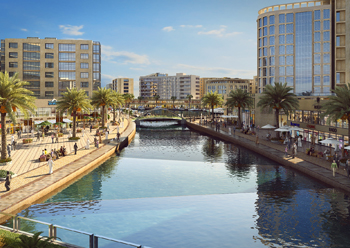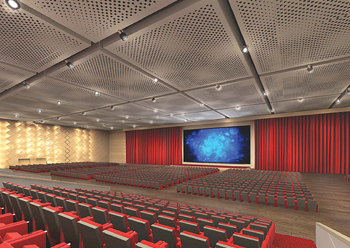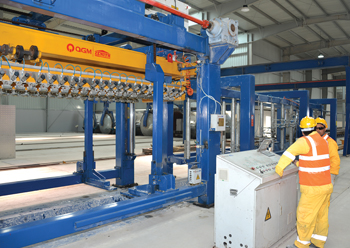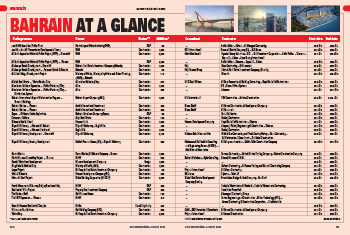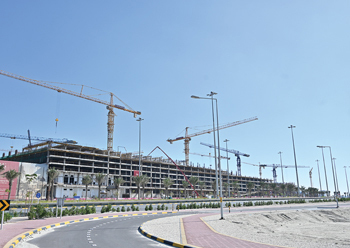

Construction work on Bahrain International Airport’s (BIA) new passenger terminal building is in its final stages as the state-of-the-art facility gears up to usher in a new era of efficient and seamless travel when it becomes operational in the first quarter of 2020.
The new 210,000-sq-m terminal is four times the size of the existing one and will include a 4,600-sq-m departure hall, 104 check-in counters, 36 passport control booths and 24 security screening points.
The launch of the new facility, as part of the $1.1-billion Airport Modernisation Programme (AMP), will increase BIA’s capacity to 14 million passengers and 130,000 air traffic movements per year.
 |
|
Engineer Kamal ... the new terminal meets passengers’ growing expectations for a more seamless airport experience. |
“Our goals for the new facility are to ensure it reflects the kingdom’s distinct character and that passengers enjoy a hassle-free travel experience. Most airports are places you have to go through, but this is an airport we hope visitors will want to go to,” says His Excellency Engineer Kamal bin Ahmed Mohammed, Minister of Transportation and Telecommunications, in an interview.
Construction work on the project was launched with the award of the airport expansion contract to a team of UAE-based Arabtec and Turkey’s TAV Airports in January 2016.
According to Engineer Kamal, work on the new Passenger Terminal Building is proceeding at a faster pace than that of similar projects in the region, with all preparations under way according to schedule.
The new facility is now in the midst of the trial stage of the Operations Readiness and Airport Transfer (ORAT) programme, which will help identify additional staff training and equipment needs ahead of its inauguration.
New facilities
New services include an airport clinic, a multi-storey car-park, and a 50-room transit hotel. The new terminal’s retail areas will be three times larger, featuring a broad selection of local brands and food and beverege (F&B) outlets.
“To ensure that even transit passengers can experience Bahrain’s rich heritage and unique identity, there will be a Bahraini concept corner showcasing the kingdom’s art and culture, including museum pieces, and traditional and modern artisanal crafts,” he says.
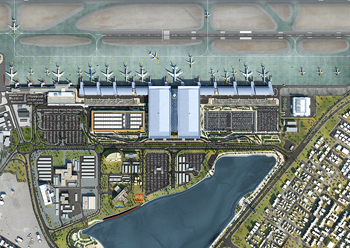 |
|
The new terminal at Bahrain International Airport. |
With its advanced technology, convenience-oriented approach, and focus on innovation, the new Passenger Terminal Building aims to put BIA on the global aviation map, he adds.
The new terminal is designed with passengers’ comfort in mind, ensuring they can traverse the Arrivals and Departures areas more smoothly. Departing passengers will be able to go from the curb to the gate in approximately 10 minutes, and the immigration process is 60 seconds for business and four minutes for economy, Engineer Kamal adds.
“From day one, the design of the new terminal was developed with passengers’ journeys in mind. We tried to visualise how passengers will navigate through the building in both their arrival and departure journeys. As such, the terminal is linear in design and very intuitive, even though it is four times the size of the existing one.
“We will have more contact gates than today, minimising the need for airplane remote stands, and we made sure that changes in elevation were kept to a minimum. Although it offers the same services and facilities as other regional airports, its ergonomic design will make BIA one of the most efficient airports in the region.
“Passengers will be able to traverse the terminal’s arrival and departure areas more quickly than at any other regional airport.
“Entering and exiting the airport will be hassle-free via a road that is dedicated to the terminal. Currently, it is a dual usage road both for the terminal and for public traffic but will be rehabilitated by the Ministry of Works,” he elaborates.
Passengers with reduced mobility will also enjoy a greatly improved experience. Furthermore, the needs of women and families have been taken into consideration in the design of the terminal, which includes a dedicated family passageway, a children’s club, and a special area for nursing.
“The new passenger terminal building will feature advanced technology to enhance efficiency, improve security, and meet passengers’ growing expectations for a more seamless airport experience.
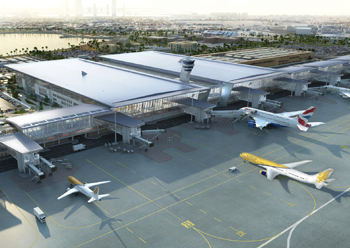 |
|
The new terminal building ... expected to use 25 per cent less energy than conventional terminals. |
“Advancements in automation will streamline some of the most time-consuming processes and procedures, giving passengers more control over their journeys. One of the game-changing technologies being implemented is a new self-bag drop system, which offers a range of benefits, including shorter passenger queues, reduced labour costs for airlines, and enhanced check-in capacity.
“There will also be two types of E-gates that verify users’ identities through biometrics, which will enable travellers to pass through immigration checkpoints faster and with less staff involvement, while still maintaining a high level of security.
“The new terminal will also feature screening machines with advanced capabilities that enhance the effectiveness of security checkpoints,” Engineer Kamal explains.
Also, sustainability has been accorded high priority in the design and construction of the new terminal building. Key Airport Modernisation Programme (AMP) projects are on track to achieve Leadership in Energy and Environmental Design (LEED) certification, including Gold certification for the new Passenger Terminal Building and West Car Park, and Silver certification for the central utility complex.
“The Passenger Terminal Building was globally recognised for its sustainable design, energy efficiency goals, and overall efforts to minimise its impact on the environment. The facility was spotlighted in Airports Council International (ACI) Asia-Pacific Green Airports Recognition 2019, an initiative that promotes environmental best practices and acknowledges ACI Asia-Pacific airport members with outstanding accomplishments in their environmental projects,” he adds.
Bahrain Airport Company (BAC), a government-owned company responsible for managing and operating the Bahrain International Airport, is committed to operating the airport as an environment-friendly and efficient facility and through the AMP, it aims to minimise the airport’s environmental impact by using sustainability strategies and materials that reduce energy and water use, improve waste management, and enhance indoor air quality.
“Although the new terminal building will be four times the size of the existing facility, it will use 25 per cent less energy than conventional terminals elsewhere in the industry. This is due to its ergonomic design, which includes highly-insulated walls, double-glazed windows, and the integration of a comprehensive shading scheme that limits heat gain into the building,” he explains.
The new terminal is also equipped with an efficient cooling system that enables energy recovery levels of 23 per cent. The system incorporates a recovery wheel that utilises cold exhaust air to cool fresh air entering the building. Furthermore, the new terminal’s potable water supply comes from a reverse osmosis plant that is tested to achieve 30 per cent energy recovery. Artificial lighting energy demand will be also reduced using LED lighting, skylight, occupancy sensors, and daylight intensity sensors.
Another important aspect of the new terminal’s design is the building management system, which controls equipment according to the fluctuating demand of systems like heating, ventilation, air-conditioning, and artificial lighting.
Apart from the new terminal building, the AMP comprises multiple projects that aim to enhance Bahrain International Airport’s infrastructure, facilities, and services. These include a fuel farm complex that will reinforce Bahrain’s position as a centre of aviation fuel services in the GCC. Housing three aviation fuel tanks with a capacity of 10,000 cu m each, the project covers 77,000 sq m, in addition to its dedicated operational buildings.
In addition, the Civil Aviation Affairs (CAA) building, which once served as Bahrain’s main airport, will be transformed into a private aviation terminal to cater to VIPs and business leaders. The renovation will ensure that the building retains its traditional character while adhering to the latest international standards. Covering an area of 4,000 sq m, the project includes a terminal, arrival and departure gates, lounges, baggage handling services, duty-free shops tailored to the needs of VIP travellers, passport and customs control areas, and dedicated parking areas. Hafeera Contracting Company was appointed the main contractor for the project in November 2019.
This apart, a new cargo area comprising warehouses, aircraft parking, and associated infrastructure is being developed to improve BIA’s cargo operations, enabling it to handle larger volumes.
A decision is yet to be made regarding the use of the old terminal, he states.





















_0001.jpg)


.jpg)
















.jpg)








.jpg)



